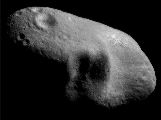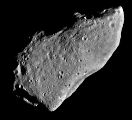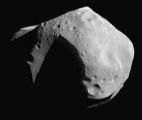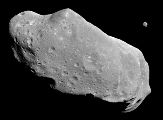by Larry
May, 2005The Odds of Collision with NEOs (and What We Can Do About Them)Almost every year a near earth object (NEO) impacts our planet with an explosive force averaging at least 5 kilotons. Three such events would equal the power of Hiroshima's World War II atomic bomb blast. Usually, we are lucky and the energy is dissipated into the atmosphere and/or the seas. But every now and then one hits land. Here the odds remain good, though, for most of the globe's surface, even with over 6 billion people spread about it, is thinly populated, and impacts only occasionally have a substantial effect on people. In March, 2003, an asteroid hit the Park Forest suburb of Chicago with the power of a mere one-third kiloton bomb, though enough to have wiped out much of that community, but fortunately the meteor had already broken apart into many tiny pieces, most of which struck harmlessly or burned up before reaching the ground. In early 2004, a good-sized rock, big enough to take out a large chunk of LA or NYC if it hit in just the wrong place, appeared to be potentially on course to strike earth within the next day and a half. The odds of collision were estimated at 1 in 4. As it turned out, the asteroid, known as 2004 AS1, missed us by a comfortable margin, but it was a rather tense time for those in the know.
Every now and then, around once every 100 years, an NEO of sufficient size comes down that has a great capacity for devastation. Such an event occurred in the Tunguska River area of central Siberia, at 7:17 AM, on June 30, 1908. Had it hit the ocean, it could have created the largest tsunami seen in thousands of years. If it impacted a population center, millions could have died. But the impact occurred in such a remote region that few people were seriously affected. Even so, 60 km (roughly 40 miles) away people were thrown to the ground by the explosive force. At around 30 km (about 20 miles) distance, reindeer herders were blown into the air by the explosion. Several were knocked unconscious. One, thrown about three dozen feet and into a tree, died of his injuries. At ground zero, over a vast, irregular distance of 3-10 miles, the forests were devastated, their trees blasted away. The forests then continued burning around the area, the fires started by the explosion's brief fireball. The pattern of destruction is believed to have been very similar to that from Mt. Saint Helens' dramatic eruption in 1980, with mile after mile of trees snapped outward from the blast center and burned, the entire area covered in ash. The smaller the NEO impact, the more likely it is to occur at any given time. To put that more optimistically, the larger it is, the lower the chances we would ever be affected. NEOs big enough to radically change our planet, as did the one that struck 65 million years ago, largely responsible for the demise of dinosaurs and the subsequent rise to dominance of mammals, can probably be seen and charted by astronomers long enough in advance of a collision that there is at least a chance something could be done to avoid the impact or lessen its effects. But many smaller NEOs may never be discovered, certainly not in time to take preventative steps. Another collision such as hit Siberia could occur without warning at any time. If a person lives to be 80, her or his odds of being around when the next multi-megaton blast (similar to what struck Siberia in 1908) occurs (somewhere on the planet) are roughly 1 in 12.5. But our chances of actually being directly injured by such an event are only around .00016%. Our likelihood of dying in an auto accident is actually much greater. This should be reassuring in light of the fact that, in spite of such films as "Armageddon," unless we can chart its path toward us decades in advance, there is essentially nothing whatever any government or individuals could do, at least with modern technology, to divert or stop an NEO on a collision course with earth.
1908 Siberia Explosion - Reconstructing an Asteroid Impact from Eyewitness Accounts. William K. Hartmann in Planetary Science Institute. Killer Impact. Bill Cooke in Astronomy, Vol. 32, No. 12, pages 38-43; December, 2004. |



